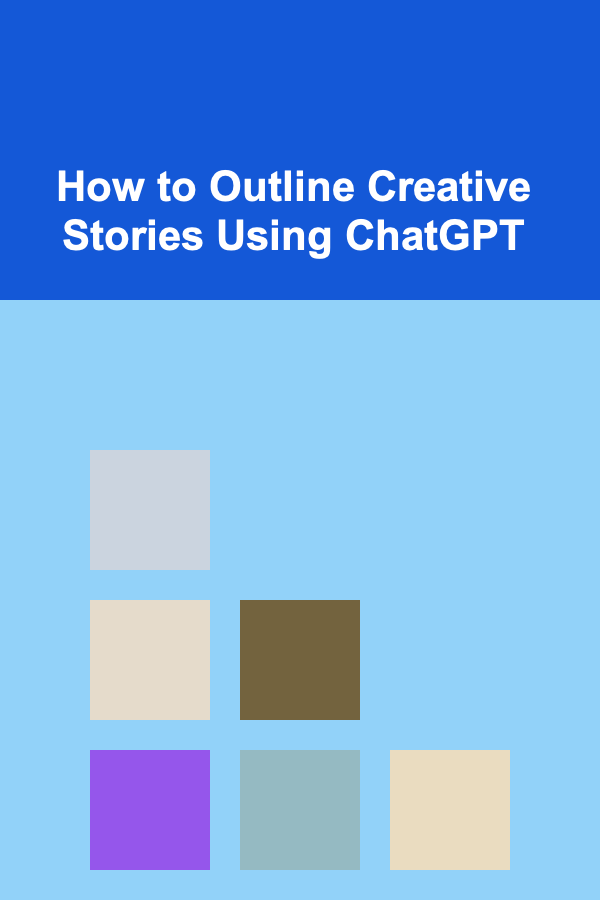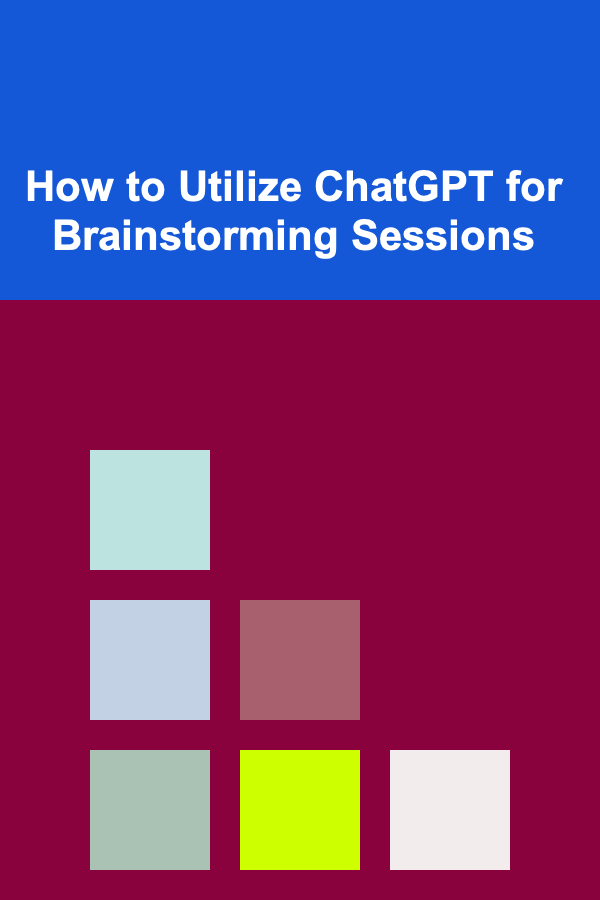
How to Outline Creative Stories Using ChatGPT
ebook include PDF & Audio bundle (Micro Guide)
$12.99$8.99
Limited Time Offer! Order within the next:

Creating a compelling story requires much more than just writing words. It involves weaving together intricate plots, developing multifaceted characters, building a world that feels alive, and ensuring that everything aligns to create a satisfying narrative experience. Whether you're an aspiring author, a screenwriter, or someone working on a creative project, outlining your story is an essential first step in transforming a vague idea into a well-structured narrative. One of the best tools at your disposal for this process is ChatGPT.
ChatGPT is a versatile and powerful AI tool that can assist you with various aspects of storytelling, from brainstorming ideas to organizing your plot structure. In this guide, we'll explore how to use ChatGPT to outline your creative stories effectively, enhancing your creative process, and providing a helpful foundation to build on.
Understanding the Power of Story Outlines
Before diving into how to use ChatGPT for outlining, it's important to understand why an outline is crucial. A well-thought-out story outline serves as the backbone of your narrative. It gives you a roadmap to follow, helping you stay focused while writing and ensuring your plot progresses smoothly.
A solid outline:
- Keeps you organized: It helps structure your thoughts and ideas, which is especially helpful if you're working on a complex story.
- Ensures pacing: It allows you to see where your story may drag or feel rushed, so you can adjust the flow accordingly.
- Provides clarity: With an outline, you can better visualize how different plot points and characters are interwoven.
- Prevents writer's block: Having a clear direction reduces uncertainty and keeps your creativity flowing.
An outline isn't set in stone, and you can always adjust it as you go, but having one is a great starting point.
How ChatGPT Can Assist in Story Outlining
ChatGPT can help you outline a story in several ways. By providing guidance, generating ideas, and helping you organize your plot, ChatGPT can be a valuable tool in both the brainstorming and structuring stages of writing.
1. Generating Story Ideas
The first challenge in storytelling is coming up with an idea that excites you. Whether you're trying to invent a fresh concept for a novel or you need a unique twist for a screenplay, ChatGPT can help spark your imagination.
How ChatGPT Helps:
- Idea brainstorming: Simply ask ChatGPT to generate story ideas based on a particular theme, genre, or premise. For example, you could ask, "Give me five unique story ideas for a sci-fi thriller" or "Suggest some unusual fantasy plot twists."
- Thematic exploration: If you already have a theme or message in mind, ChatGPT can generate ideas around that theme. You could say, "I want to write a story about love and loss, but I need unique plot ideas that explore these themes."
- Genre exploration: ChatGPT can suggest ideas based on popular genres or niche sub-genres. For example, "Can you suggest some mystery novel ideas with a supernatural twist?"
2. Developing Your Plot Structure
Once you have an idea, the next step is to build a structure around it. This is where outlining becomes critical. A plot structure gives your story direction and ensures that all the necessary elements are present. ChatGPT can help you brainstorm and organize key plot points, ensuring that you create a coherent and engaging narrative.
How ChatGPT Helps:
- Three-Act Structure: The three-act structure is a tried-and-true method for organizing a story. You can ask ChatGPT to help you break your plot into the three acts: setup, confrontation, and resolution. For example, "Help me outline a three-act structure for my fantasy story about a lost prince."
- Plot Points and Beats: You can ask ChatGPT to suggest specific plot points and narrative beats that align with your genre. For instance, you might ask, "What are the key plot points for a thriller about a detective solving a cold case?"
- Conflict Development: Conflict is the heart of any good story. ChatGPT can help you develop internal and external conflicts for your characters. Ask, "What kinds of internal conflicts can I give my protagonist in a dystopian story?"
3. Creating Complex Characters
Your story's characters are its soul. Without compelling characters, even the most exciting plot will fall flat. ChatGPT can assist in crafting multidimensional characters, helping you explore their motivations, desires, and conflicts.
How ChatGPT Helps:
- Character creation: Ask ChatGPT to generate characters based on specific attributes, such as personality traits, roles, and goals. For example, "Create a detailed character for a young, ambitious lawyer who is facing a moral dilemma."
- Backstory development: ChatGPT can assist in generating complex backstories for your characters. If you're struggling with your character's past, simply ask, "What kind of backstory could shape a character who grew up in an abusive household but became a successful entrepreneur?"
- Character relationships: Ask ChatGPT to suggest the dynamics between your characters. For instance, you could say, "What kind of relationship could my protagonist have with their childhood friend, who has now become their rival?"
4. Building the World of Your Story
A well-crafted world can elevate your story, making it feel immersive and real. Whether you're writing a historical novel or creating an entirely new fantasy realm, ChatGPT can help you develop the details of your world, from the setting to the culture to the rules that govern it.
How ChatGPT Helps:
- World-building: Ask ChatGPT to help you create a world with specific rules and features. You can specify the genre and ask for world-building prompts like, "Describe a post-apocalyptic world where technology is forbidden" or "What would a medieval fantasy city look like in the midst of war?"
- Setting exploration: The setting plays a major role in shaping the mood and tone of your story. ChatGPT can help you come up with settings that align with your plot. Ask, "What is a suitable setting for a horror story that takes place inside an abandoned mansion?"
- Cultural details: If your story takes place in a particular culture, whether real or fictional, ChatGPT can help you flesh out cultural norms, traditions, and societal structures. Ask, "What traditions would be common in a dystopian society where technology controls every aspect of life?"
5. Generating Plot Twists and Unexpected Turns
Plot twists are a great way to keep your readers engaged, and ChatGPT is excellent at suggesting unexpected turns and surprises that can make your story more compelling.
How ChatGPT Helps:
- Surprising plot developments: Ask ChatGPT to suggest potential plot twists or unexpected developments for your story. For example, "What would be a shocking twist for a detective story where the detective is hunting a serial killer?"
- Character revelations: Characters often evolve throughout a story, and ChatGPT can help you brainstorm moments of revelation that change the trajectory of the plot. Ask, "What is a surprising secret my protagonist might uncover about their mentor?"
- Climactic moments: ChatGPT can also help you generate high-stakes moments that serve as turning points in your story. Ask, "What could be a climactic moment in a thriller about corporate espionage?"
6. Creating Dialogue and Scene Outlines
Once your characters, plot, and setting are in place, you need to focus on how to present them through scenes and dialogue. Writing dynamic and engaging dialogue is key to bringing your story to life, and ChatGPT can assist you in generating realistic conversations between characters.
How ChatGPT Helps:
- Dialogue prompts: Ask ChatGPT for suggestions on how your characters might speak to each other in various situations. For example, "What would a confrontation between my protagonist and their enemy look like in a post-apocalyptic world?"
- Scene breakdowns: You can ask ChatGPT to help break down scenes into key moments. For instance, "Help me outline a tense scene where my protagonist confronts their best friend about a betrayal."
- Conflict and tension: Dialogue is often the best way to express conflict. Ask ChatGPT to generate dialogue that reveals the underlying tension between characters. For example, "Write a conversation between two characters who are trying to hide their true feelings for each other."
7. Finalizing the Story Outline
Once you have a comprehensive outline in place, you can use ChatGPT to fine-tune your ideas, ensuring that everything flows logically and smoothly.
How ChatGPT Helps:
- Review and refinement: ChatGPT can help you review your outline and suggest areas where the pacing might be off or where additional conflict is needed. You could ask, "Can you review my plot outline and suggest improvements?"
- Coherence check: If you're unsure whether certain plot points align with the story's tone or theme, ask ChatGPT to help ensure consistency. For example, "Does my plot outline make sense for a dark fantasy story with a tragic ending?"
- Feedback and revisions: Finally, if you're feeling unsure about any aspect of your outline, ChatGPT can help you brainstorm alternative approaches. Ask, "What are some different ways I could resolve the conflict in my story?"
Conclusion
Outlining a creative story is a critical step in the writing process, and ChatGPT can be an invaluable resource in helping you organize and structure your ideas. From generating story ideas to developing characters and plot twists, ChatGPT can assist you every step of the way, ensuring that you create a well-rounded, compelling narrative. Whether you're writing your first novel or your fiftieth screenplay, using ChatGPT as part of your outlining process will help you stay organized, reduce writer's block, and bring your creative vision to life.
The key to a successful story outline is not just in having all the right elements but in weaving them together in a way that feels cohesive, engaging, and meaningful. With ChatGPT as your storytelling partner, you'll have the tools you need to craft stories that captivate your audience from start to finish.

How to Organize a Family Photography Day
Read More
How to Prepare Your Rental Property for New Tenants
Read More
How to Set Competitive Rental Rates
Read More
How to Utilize ChatGPT for Brainstorming Sessions
Read More
How To Optimize Your Brain for Productivity
Read More
How to Preserve Local History as a Librarian
Read MoreOther Products

How to Organize a Family Photography Day
Read More
How to Prepare Your Rental Property for New Tenants
Read More
How to Set Competitive Rental Rates
Read More
How to Utilize ChatGPT for Brainstorming Sessions
Read More
How To Optimize Your Brain for Productivity
Read More